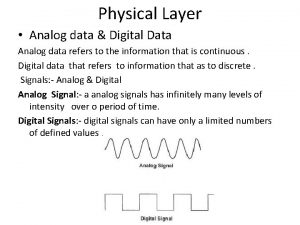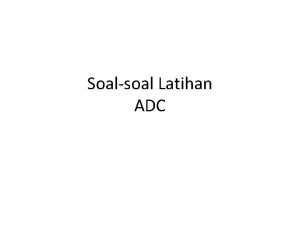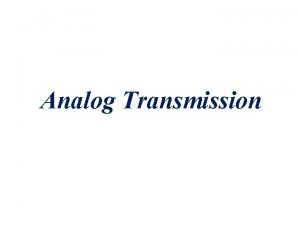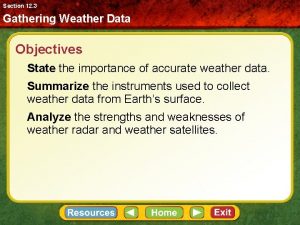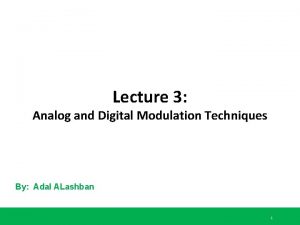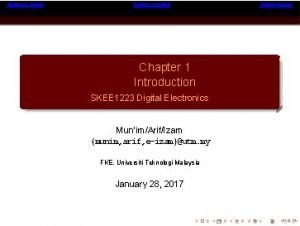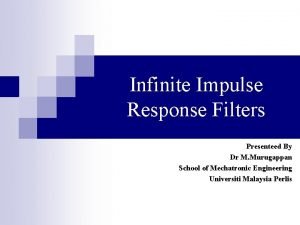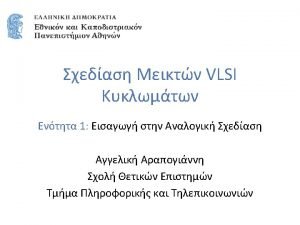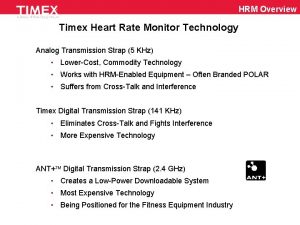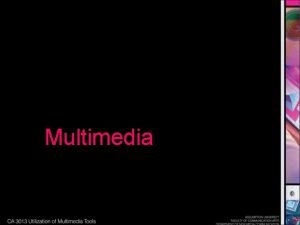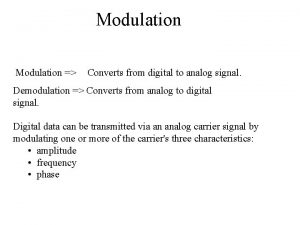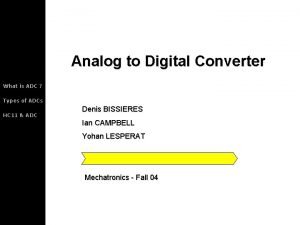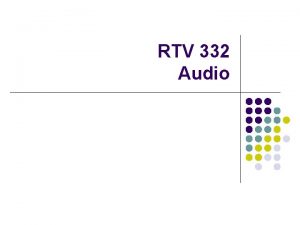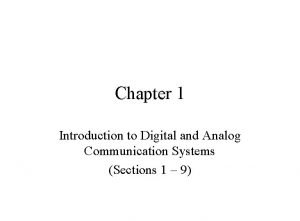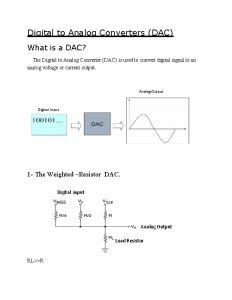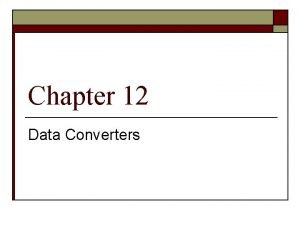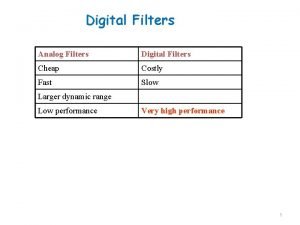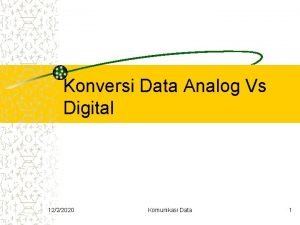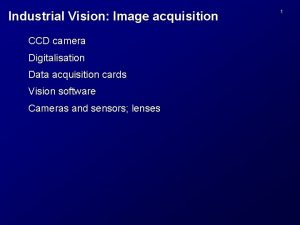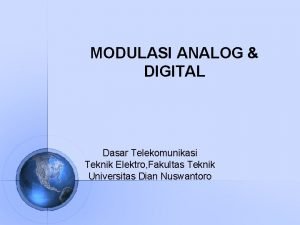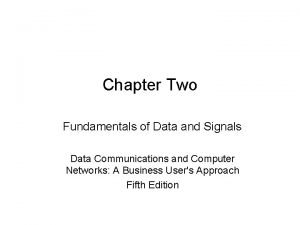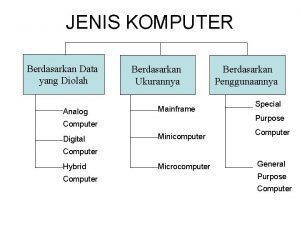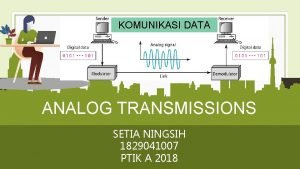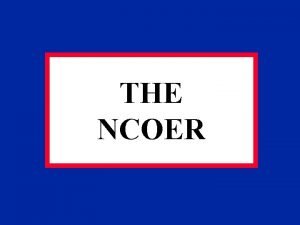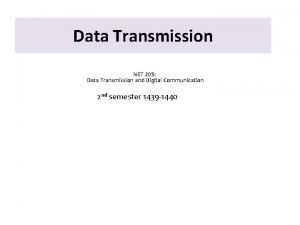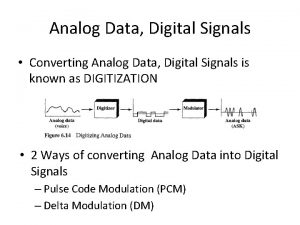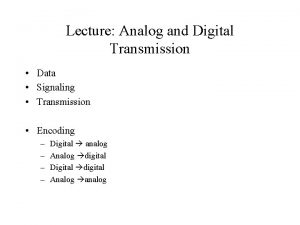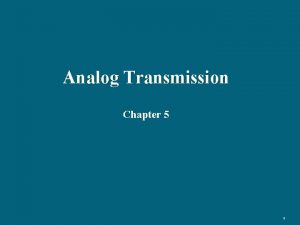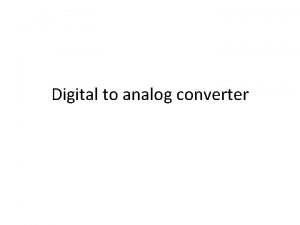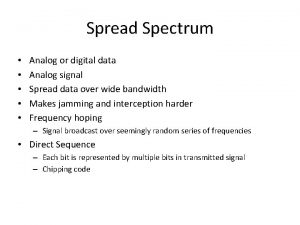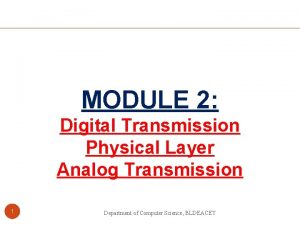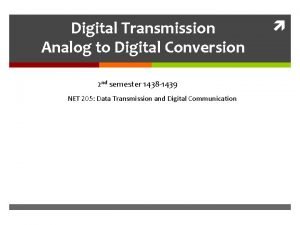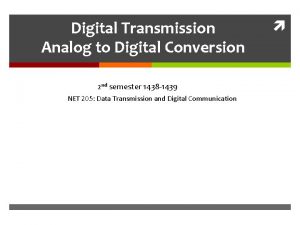Analog Transmission NET 205 Data Transmission and Digital














































- Slides: 46

Analog Transmission NET 205: Data Transmission and Digital Communication 2 nd semester 1439 -1440

205 NET CLO • 1 -Introduction to Communication Systems and Networks architecture OSI Reference Model. • 2 - Data Transmission Principles • 3 - Transmission medias • 4 - Data modulation and encoding 2

Data Modulation And Encoding

Outline ü Introduction ü Modulation of Digital Data ü Amplitude Shift Keying ü Frequency Shift Keying ü Phase Shift Keying ü Quadrature Amplitude Modulation ü Modulation of Analog Data ü Amplitude Modulation ü Frequency Modulation ü Phase Modulation 4

Introduction 5

Channel Properties • A communication channel only operates at a certain frequency range. • Channels are either be – low-pass – band-pass channels. nalhareqi-2016 6

Analog • The source typically produces a low frequency signal , referred to as the “baseband signal”. • The baseband signals are not suitable for direct transmission over band-pass channels. nalhareqi-2016 7

Digital Analog • 1) The channel is band-pass, and/or • 2) Multiple users need to share the medium – microwave systems.

Modulation • It is the process of converting digital data or a lowpass analog to band-pass (higher-frequency) analog signal 9

Carrier Signal • Carrier Signal: is a high frequency signal that acts as a basis for the information signal

Modulation translates a signal from its baseband to the operating range of the channel nalhareqi-2016 11

Outline ü Introduction ü Modulation of Digital Data ü Amplitude Shift Keying ü Frequency Shift Keying ü Phase Shift Keying ü Quadrature Amplitude Modulation ü Modulation of Analog Data ü Amplitude Modulation ü Frequency Modulation ü Phase Modulation 12

Modulation of Digital Data • Digital-to-analog modulation is the process of changing one of the characteristics of an analog signal – carrier signal (sinusoidal signal) based on the information in digital data. • This kind of modification is called modulation (shift keying). 13

Types of Digital-to-Analog Conversion 14

Amplitude Shift Keying • In amplitude shift keying (ASK), the amplitude of the carrier signal is varied to represent binary 1 or 0 – frequency and phase remain constant while amplitude changes. 15

Binary ASK • A popular ASK technique is the binary ASK (on-off keying (OOK)). – On of the amplitude is zero

Implementation of Binary ASK 17

Example • We have an available bandwidth of 100 k. Hz which spans from 200 to 300 k. Hz. What are the carrier frequency if we modulated our data by using ASK ? • Solution The middle of the bandwidth is located at 250 k. Hz. This means that our carrier frequency can be at fc = 250 k. Hz. 18

Example • In data communications, we normally use full-duplex links with communication in both directions. We need to divide the bandwidth into two with two carrier frequencies, as shown in figure. The figure shows the positions of two carrier frequencies and the bandwidths. The available bandwidth for each direction is now 50 k. Hz. 19

Amplitude Shift Keying • Demodulation: only the presence or absence of a sinusoid in a given time interval needs to be determined • Advantage: simplicity • Disadvantage: ASK is very susceptible to noise interferencenoise usually (only) affects the amplitude, therefore ASK is the modulation technique most affected by noise • Application: ASK is used to transmit digital data over optical fiber

Multilevel ASK • We can have multilevel ASK in which there are more than two levels. • We can use 4, 8, 16, or more different amplitudes for the signal and modulate the data using 2, 3, 4, or more bits at a time. 21

Frequency Shift Keying • In frequency shift keying (FSK), the frequency of the carrier signal is varied to represent binary 1 or 0. – Both peak amplitude and phase remain constant. 22


Frequency Shift Keying • demodulation: demodulator must be able to determine which of two possible frequencies is present at a given time • advantage: FSK is less susceptible to errors than ASK – receiver looks for specific frequency changes over a number of intervals, so voltage (noise) spikes can be ignored • disadvantage: FSK spectrum is 2 x ASK spectrum • application: over voice lines, in high-freq. radio transmission, etc.

Multilevel FSK • We can use more than two frequencies. For example, we can use four different frequencies f 1, f 2, f 3, and f 4 to send 2 bits at a time. • However, we need to remember that the frequencies need to be apart of each other. 25

Phase Shift Keying • In phase shift keying, the phase of the carrier is varied to represent binary 1 or 0 – Both peak amplitude and frequency remain constant. • In binary PSK, we have only two signal elements: one with a phase of 0°, and the other with a phase of 180°. 26

Phase Shift Keying • PSK is equivalent to multiplying carrier signal by +1 when the information is 1, and by -1 when the information is 0

Implementation of BPSK 28

Phase Shift Keying • demodulation: demodulator must determine the phase of received sinusoid with respect to some reference phase • advantage: PSK is less susceptible to errors than ASK, PSK is superior to FSK because we do not need two carrier signals, The bandwidth for BPSK is same as that for binary ASK. • disadvantage: more complex signal detection / recovery process, than in ASK and FSK

Quadrature PSK QPSK = 4 PSK = PSK that uses phase shifts of 90º= π/2 rad ⇒ 4 different signals generated, each representing 2 bits 30

Quadrature PSK

Quadrature PSK • advantage: higher data rate than in PSK (2 bits per bit interval), while bandwidth occupancy remains the same • 4 -PSK can easily be extended to 8 -PSK, i. e. n-PSK • however, higher rate PSK schemes are limited by the ability of equipment to distinguish small differences in phase

Quadrature Amplitude Modulation • Quadrature amplitude modulation is a combination of ASK and PSK. • The possible variations of QAM are numerous 33

Ex: Time domain for an 8 -QAM signal 34

Outline ü Introduction ü Modulation of Digital Data ü Amplitude Shift Keying ü Frequency Shift Keying ü Phase Shift Keying ü Quadrature Amplitude Modulation ü Modulation of Analog Data ü Amplitude Modulation ü Frequency Modulation ü Phase Modulation 35

Modulation of Analog Data • Analog-to-analog conversion, or analog modulation, is the representation of analog information by an analog signal. • One may ask why we need to modulate an analog signal; it is already analog. Modulation is needed if the medium is band-pass in nature or if only a band-pass bandwidth is available to us. 36

Types of Analog-to-Analog Modulation • Analog-to-analog conversion can be accomplished in three ways: 37

Amplitude Modulation (AM) • In AM transmission, the carrier signal is modulated so that its amplitude varies with the changing amplitudes of the modulating signal. – The frequency and phase of the carrier remain the same; The modulating signal is the envelope of the carrier 38

AM Bandwidth • The modulation creates a bandwidth that is twice the bandwidth of the modulating signal and covers a range centered on the carrier frequency. 39

Standard Bandwidth Allocation for AM Radio • The BW of an audio signal (speech and music) is usually 5 k. Hz. an AM radio station needs a BW of 10 k. Hz • AM stations are allowed carrier frequencies anywhere between 530 and 1700 k. Hz • However, each station's carrier frequency must be separated from those on either side of it by at least 10 k. Hz (one AM bandwidth) to avoid interference. 40

Frequency Modulation • In FM transmission, the frequency of the carrier signal is modulated to follow the changing voltage level (amplitude) of the modulating signal. – The peak amplitude and phase of the carrier signal remain constant 41

FM Bandwidth • The total bandwidth required for FM BFM = 2(1 + β)B β is a factor depends on modulation technique with a common value of 4. 42

Standard Bandwidth Allocation for FM Radio • The bandwidth of an audio signal (speech and music) broadcast in stereo is almost 15 k. Hz. • The FCC allows 200 k. Hz (0. 2 MHz) for each station. This mean β = 4 with some extra guard band. • FM stations are allowed carrier frequencies anywhere between 88 and 108 MHz. 43

Standard Bandwidth Allocation for FM Radio • Stations must be separated by at least 200 k. Hz to keep their bandwidths from overlapping. • To create even more privacy, the FCC requires that in a given area, only alternate bandwidth allocations may be used. The others remain unused to prevent any possibility of two stations interfering with each other. 44

Phase Modulation • In PM transmission, the phase of the carrier signal is modulated to follow the changing voltage level (amplitude) of the modulating signal. – The peak amplitude and frequency of the carrier signal remain constant. 45

Any Questions ? 46
 Analog and digital transmission
Analog and digital transmission Analog signla
Analog signla Contoh soal adc
Contoh soal adc Digital to analog conversion in data communication
Digital to analog conversion in data communication Compare and contrast analog and digital forecasting
Compare and contrast analog and digital forecasting Compare and contrast analog and digital forecasting
Compare and contrast analog and digital forecasting Disadvantages of fsk
Disadvantages of fsk Analog and digital video in multimedia
Analog and digital video in multimedia Digital vs analog video
Digital vs analog video Analog image and digital image
Analog image and digital image Analogue and digital transmission in computer networks
Analogue and digital transmission in computer networks Vhmin
Vhmin Digital and analog quantities
Digital and analog quantities S domain
S domain Analog and digital video in multimedia
Analog and digital video in multimedia Compare analog and digital filters
Compare analog and digital filters Introduction to analog and digital control systems
Introduction to analog and digital control systems Razavi cmos analog circuit design
Razavi cmos analog circuit design Digital data digital signals
Digital data digital signals Timex digital flex tech hrm sensor
Timex digital flex tech hrm sensor Apa yang dimaksud teknologi digital
Apa yang dimaksud teknologi digital Analog vs digital
Analog vs digital Modulation digital to analog
Modulation digital to analog Perbedaan analog dan digital
Perbedaan analog dan digital Dual slope adc advantages and disadvantages
Dual slope adc advantages and disadvantages Single slope adc
Single slope adc Pengertian adc
Pengertian adc Digital vs analog sound
Digital vs analog sound Digital signal as a composite analog signal
Digital signal as a composite analog signal Analog vs digital communication systems
Analog vs digital communication systems Kelebihan modulasi digital dibandingkan modulasi analog
Kelebihan modulasi digital dibandingkan modulasi analog Digital to analog converter
Digital to analog converter Digital to analog converters basic concepts
Digital to analog converters basic concepts Analog encoding
Analog encoding Tap digital
Tap digital Analog vs digital
Analog vs digital Contoh alat dengan konsep elektronika analog
Contoh alat dengan konsep elektronika analog Digital image acquisition for analog sem
Digital image acquisition for analog sem Modulasi adalah
Modulasi adalah Digital data digital signals
Digital data digital signals Digital encoding schemes
Digital encoding schemes Advantage and disadvantage of dpcm
Advantage and disadvantage of dpcm Analog data examples
Analog data examples Jenis komputer berdasarkan data yang diolah
Jenis komputer berdasarkan data yang diolah Sifat khas dari data analog adalah
Sifat khas dari data analog adalah Sifat khas dari data analog
Sifat khas dari data analog Ar 623-205
Ar 623-205

